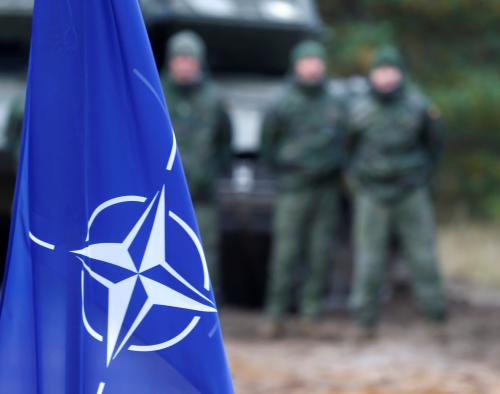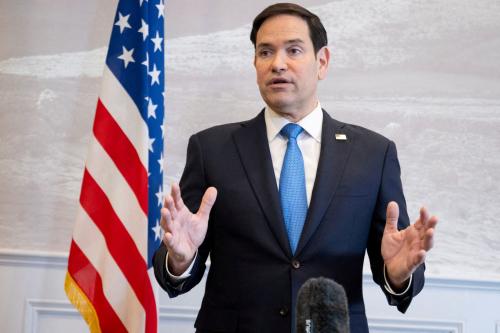It’s become increasingly clear that outer space is a key domain of U.S. and international security, and the Trump administration has made it a priority in recent years. On June 17, the Department of Defense (DOD) released a summary of its new Defense Space Strategy (DSS). The document outlines a strategy for advancing U.S. military space power over the next 10 years.
Some experts have criticized the strategy, arguing that it lacks sufficient detail and coordination, especially when compared to the 2011 Obama administration National Security Space Strategy, issued jointly by DOD and the Office of the Director of National Intelligence. Though some of these criticisms are fair, overall, the DSS provides the guidance that DOD needs to plan and structure its forces to address the increasing threat to U.S. and allied systems from countries like Russia and China.
The biggest challenges the strategy faces are fundamentally political. While it rightly recommends that the United States increase space cooperation with allies, the statements appear directly at odds with President Trump’s negative rhetoric and actions towards key U.S. allies. Moreover, terms like “space superiority” are politically problematic. Russia and China will use them to falsely claim that the United States is responsible for “weaponizing” outer space, even though it is those countries that are aggressively developing and deploying anti-satellite weapons.
What the strategy says
The strategic context for the DSS begins by stating that “space is a domain that has reemerged as a central arena of great power competition, primarily with Russia and China.” It describes how Russia, China, and other countries like Iran and North Korea are developing anti-satellite and counter-space systems “designed to contest or deny U.S. access to and operations in the [space] domain.” This is consistent with several recent space threat assessments published by the Office of the Director of National Intelligence, Defense Intelligence Agency, and the National Air and Space Intelligence Center, and private organizations like the Center for Strategic and International Studies and the Secure World Foundation.
In response to that growing anti-satellite threat, the DSS outlines three overarching defense objectives to guide DOD’s space planning over the next decade:
- “Maintain space superiority: DOD will establish, maintain, and preserve U.S. freedom of operations in the space domain. DOD will be prepared to protect and defend the U.S. and, as directed, allied, partner, and commercial space capabilities and to deter and defeat adversary hostile use of space.”
- “Provide space support to national, joint, and combined operations: DOD space forces will deliver advanced space capabilities and effects to enable national, joint, and combined operations in any domain through sustained, comprehensive space military advantages. DOD will leverage and bolster a thriving domestic civil and commercial space industry.”
- “Ensure space stability: In cooperation with allies and partners, DOD will maintain persistent presence in space in order to deter aggression in space; provide for safe transit in, to, and through space; uphold internationally accepted standards of responsible behavior as a good steward of space; and support U.S. leadership in space traffic management and the long-term sustainability of outer space activities.”
Though I have concerns about some of the specific language used to describe these goals (more on that later), they seem to be largely consistent with the goals in previous U.S. national security space policy documents. For example, the 2011 Obama document states that the three U.S. national security space objectives were to “strengthen safety, stability, and security in space; maintain and enhance the strategic national security advantages afforded to the United States by space; and energize the space industrial base that supports U.S. national security.” While the language used is somewhat different than the DSS, the overarching objectives are similar.
To implement these objectives, the DSS lays out broad lines of effort:
- “Build a comprehensive military advantage in space;
- Integrate military space power into national, joint, and combined operations;
- Shape the strategic environment; and
- Cooperate with allies, partners, industry, and other U.S. government departments and agencies.”
Each of the lines of effort directs DOD to take a specific actions to enable the strategy’s implementation: “build[ing] out the U.S. Space Force”; “improv[ing] intelligence and command and control capabilities”; enabling U.S. Space Command to better execute space operations across the spectrum; “inform[ing] international and public audiences of growing adversarial threats in space”; “promot[ing] standards and norms of behavior favorable to the U.S., allied, and partner interests”; “align[ing] with allies and partners on space policy”; and “leverage[ing] commercial technological advancements and acquisition processes.”
Critics say, among others things, that the DSS fails to adequately connect “ends and means” and lacks the necessary detail of previous space strategy documents. But as a DOD spokesperson noted recently: “Most strategies that the Department [of Defense] does are classified and we do an unclassified summary of them. What went out to the public is an unclassified summary that does not contain the full detail.” Furthermore, as with similar defense strategy documents, it is not uncommon for DOD to provide more detailed implementation guidance as needed.
Overall, I think the strategy provides DOD the necessary high-level guidance to achieve the stated objectives, though it’s a bit odd that the DOD waited to release the strategy until the final months of the Trump administration’s first term. That said, the DSS also faces significant challenges.
Political challenges
The fundamental challenges the DSS faces are political in nature. The strategy suffers from the same core weakness as previous Trump administration defense strategy documents: The document is prepared by the national security establishment and is not fully reflective of president’s views. This was my key criticism of the Trump administration’s two previous strategic capability reviews, 2018 Nuclear Posture Review and 2019 Missile Defense Review. The most glaring example of this disconnect in the DSS is over the role of U.S. allies in the strategy. The DSS argues that expanding cooperation with allies and partners will be critical to its successful implementation. I made a similar point in my 2018 testimony before Congress, stressing that America’s system of alliances was one of its key asymmetric advantages with Russia and China, especially with regard to emerging domains like space and cyber.
Unfortunately, President Trump does not seem to share these views. On June 5, two weeks before the release of the DSS, the Wall Street Journal reported that the president planned to withdraw 9,500 troops from Germany; he subsequently confirmed the report. According to these reports, the Trump administration made the decision to withdraw U.S. forces without any prior notice or consultation with Germany or any other NATO ally! As one senior German defense official quoted in the article stated: “This move will not help friends of the U.S. in Germany who are working hard to preserve the trans-Atlantic relationship, but it will boost anti-American sentiment that is spreading here.”
The irony is that Germany is one of the United States’ most active national security space partners. Over the past several years, the U.S. and Germany have taken a number of significant actions to increase cooperation in the space arena, including signing an agreement to share space situational awareness services and information; assigning a German liaison officer to the U.S. Joint Functional Component Command for Space; and collaborating in the Combined Space Operations Center, which was established to improve operational coordination and capabilities between the U.S. and its allies. Furthermore, Germany has been quietly, but surely, acquiring and operating national security satellites and other space capabilities that will contribute to overall alliance security. Trump’s unwise actions towards Germany and other allies have the potential to undermine support for our joint work on space security and other critical defense cooperation initiatives.
The second political challenge the DSS faces is that similar to the Bush administration’s controversial 2006 National Space Policy, it contains a number of politically loaded terms. In particular, it revives the term “space superiority.” There is no doubt that the U.S. military will need to develop and deploy the capabilities necessary to deter, and if deterrence fails, defeat enemies in all warfighting domains, including space. At the same time, we must also recognize that competition with Russia and China will not take place exclusively in the military domain, but in political and diplomatic domains as well. Russia and China are actively using propaganda and disinformation to shape the international environment. Therefore, the U.S. must ensure that it does not provide easy fodder that could be used to discredit the United States in international forums, and drive wedges with allies. As the Director of National Intelligence noted in 2019, strategic competitors like Russia and China will use “influence operations to try to weaken democratic institutions, undermine U.S. alliances and partnerships, and shape policy outcomes in the United States.”
Space security has traditionally been one of the perennial issues that Russia and China have used in diplomatic forums like the United Nations General Assembly (UNGA) and the Conference on Disarmament (CD) to claim it is the United States that is “weaponizing” outer space. Indeed, Russia and China have been moderately successful in advancing their diplomatic agenda in this area with initiatives like the No First Place of Weapons in Outer Space resolution at the UNGA, and the introduction of their draft Prevention of Place of Weapons in Outer Space Treaty in the CD. By re-introducing politically loaded terms like “space superiority,” the Trump administration is making Russia and China’s disinformation campaign that much easier. Not surprisingly, on June 19, the Russian Foreign Ministry released a statement on the DSS that noted:
The document confirms Washington’s aggressive policy in the space area. The final goal is clearly indicated – to ensure America’s space superiority … We carefully monitor Washington’s aggressive endeavors and carefully analyze possible consequences. Russia holds a completely opposite position by prioritizing the use and study exclusively within a peaceful context, and preventing an arms race in space.
Words matter in international politics.
As I have noted elsewhere, words matter in international politics, and the United States needs to be cognizant of this as it moves forward on the space issue.
What next?
Overall, the DSS does a solid job outlining an effective strategy for advancing U.S. defense space objectives over the next 10 years. But political challenges, especially President Trump’s view of the role of allies in U.S. defense strategy, raise serious questions as to whether it can be implemented. This is essentially the same fate that has befallen the Trump administration’s other defense strategy reviews. Absent a fundamental change in the president’s worldview, it is difficult to see how the story of the DSS will be any different.
The Brookings Institution is committed to quality, independence, and impact.
We are supported by a diverse array of funders. In line with our values and policies, each Brookings publication represents the sole views of its author(s).









Commentary
The U.S. Defense Space Strategy works on paper, but will it be implemented?
July 6, 2020